2016 NISSAN VERSA NOTE lights
[x] Cancel search: lightsPage 330 of 402
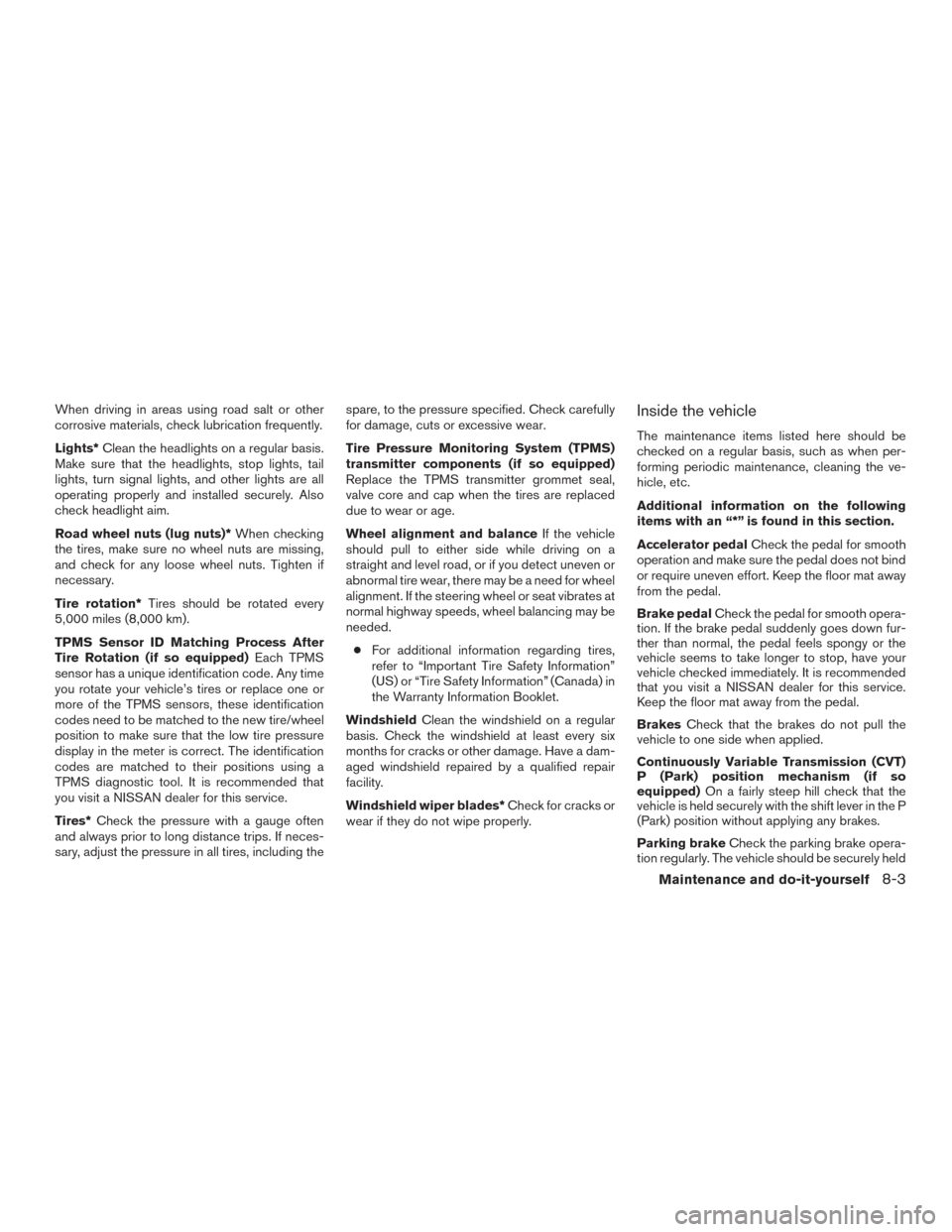
When driving in areas using road salt or other
corrosive materials, check lubrication frequently.
Lights*Clean the headlights on a regular basis.
Make sure that the headlights, stop lights, tail
lights, turn signal lights, and other lights are all
operating properly and installed securely. Also
check headlight aim.
Road wheel nuts (lug nuts)* When checking
the tires, make sure no wheel nuts are missing,
and check for any loose wheel nuts. Tighten if
necessary.
Tire rotation* Tires should be rotated every
5,000 miles (8,000 km).
TPMS Sensor ID Matching Process After
Tire Rotation (if so equipped) Each TPMS
sensor has a unique identification code. Any time
you rotate your vehicle’s tires or replace one or
more of the TPMS sensors, these identification
codes need to be matched to the new tire/wheel
position to make sure that the low tire pressure
display in the meter is correct. The identification
codes are matched to their positions using a
TPMS diagnostic tool. It is recommended that
you visit a NISSAN dealer for this service.
Tires* Check the pressure with a gauge often
and always prior to long distance trips. If neces-
sary, adjust the pressure in all tires, including the spare, to the pressure specified. Check carefully
for damage, cuts or excessive wear.
Tire Pressure Monitoring System (TPMS)
transmitter components (if so equipped)
Replace the TPMS transmitter grommet seal,
valve core and cap when the tires are replaced
due to wear or age.
Wheel alignment and balance
If the vehicle
should pull to either side while driving on a
straight and level road, or if you detect uneven or
abnormal tire wear, there may be a need for wheel
alignment. If the steering wheel or seat vibrates at
normal highway speeds, wheel balancing may be
needed.
● For additional information regarding tires,
refer to “Important Tire Safety Information”
(US) or “Tire Safety Information” (Canada) in
the Warranty Information Booklet.
Windshield Clean the windshield on a regular
basis. Check the windshield at least every six
months for cracks or other damage. Have a dam-
aged windshield repaired by a qualified repair
facility.
Windshield wiper blades* Check for cracks or
wear if they do not wipe properly.Inside the vehicle
The maintenance items listed here should be
checked on a regular basis, such as when per-
forming periodic maintenance, cleaning the ve-
hicle, etc.
Additional information on the following
items with an “*” is found in this section.
Accelerator pedal Check the pedal for smooth
operation and make sure the pedal does not bind
or require uneven effort. Keep the floor mat away
from the pedal.
Brake pedal Check the pedal for smooth opera-
tion. If the brake pedal suddenly goes down fur-
ther than normal, the pedal feels spongy or the
vehicle seems to take longer to stop, have your
vehicle checked immediately. It is recommended
that you visit a NISSAN dealer for this service.
Keep the floor mat away from the pedal.
Brakes Check that the brakes do not pull the
vehicle to one side when applied.
Continuously Variable Transmission (CVT)
P (Park) position mechanism (if so
equipped) On a fairly steep hill check that the
vehicle is held securely with the shift lever in the P
(Park) position without applying any brakes.
Parking brake Check the parking brake opera-
tion regularly. The vehicle should be securely held
Maintenance and do-it-yourself8-3
Page 331 of 402
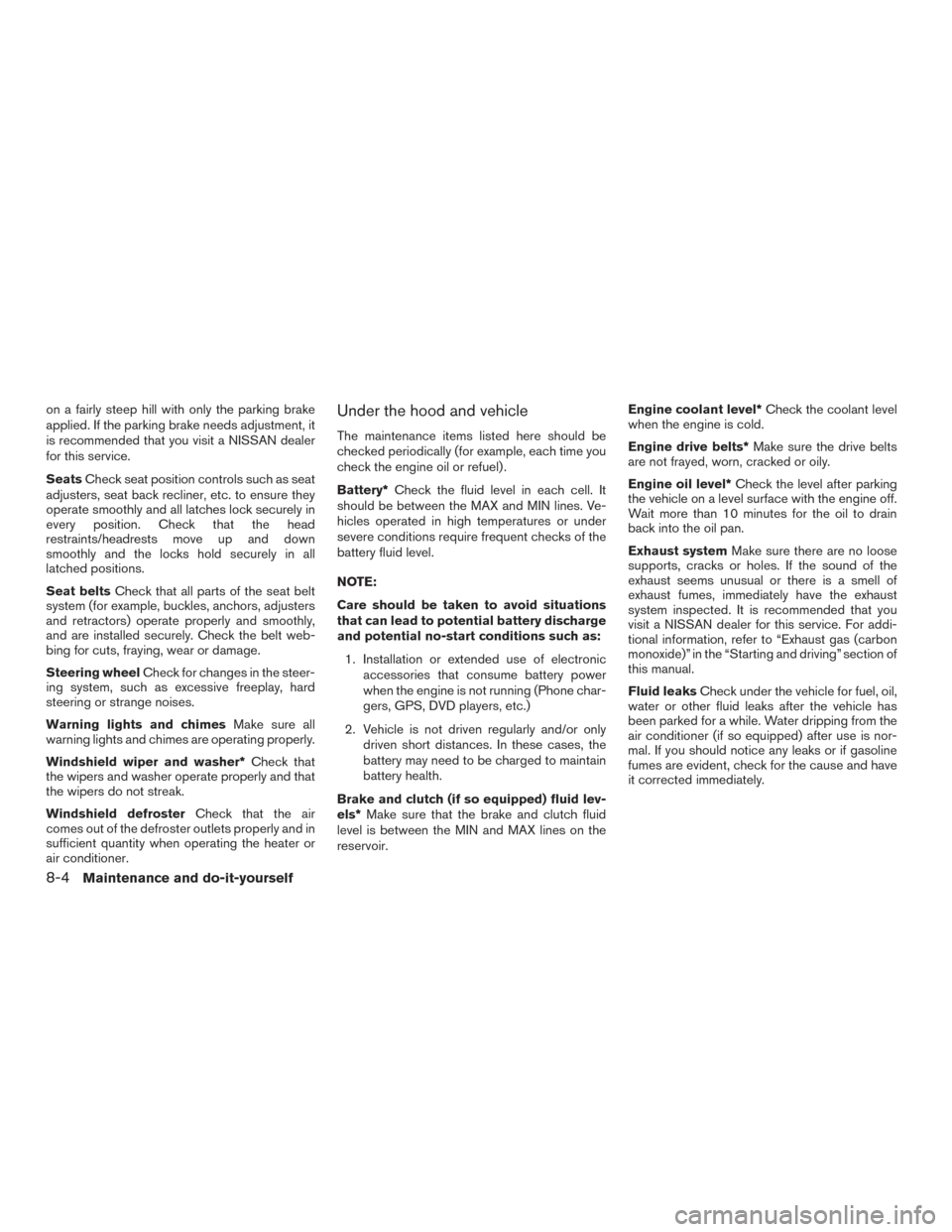
on a fairly steep hill with only the parking brake
applied. If the parking brake needs adjustment, it
is recommended that you visit a NISSAN dealer
for this service.
SeatsCheck seat position controls such as seat
adjusters, seat back recliner, etc. to ensure they
operate smoothly and all latches lock securely in
every position. Check that the head
restraints/headrests move up and down
smoothly and the locks hold securely in all
latched positions.
Seat belts Check that all parts of the seat belt
system (for example, buckles, anchors, adjusters
and retractors) operate properly and smoothly,
and are installed securely. Check the belt web-
bing for cuts, fraying, wear or damage.
Steering wheel Check for changes in the steer-
ing system, such as excessive freeplay, hard
steering or strange noises.
Warning lights and chimes Make sure all
warning lights and chimes are operating properly.
Windshield wiper and washer* Check that
the wipers and washer operate properly and that
the wipers do not streak.
Windshield defroster Check that the air
comes out of the defroster outlets properly and in
sufficient quantity when operating the heater or
air conditioner.Under the hood and vehicle
The maintenance items listed here should be
checked periodically (for example, each time you
check the engine oil or refuel) .
Battery* Check the fluid level in each cell. It
should be between the MAX and MIN lines. Ve-
hicles operated in high temperatures or under
severe conditions require frequent checks of the
battery fluid level.
NOTE:
Care should be taken to avoid situations
that can lead to potential battery discharge
and potential no-start conditions such as:
1. Installation or extended use of electronic accessories that consume battery power
when the engine is not running (Phone char-
gers, GPS, DVD players, etc.)
2. Vehicle is not driven regularly and/or only driven short distances. In these cases, the
battery may need to be charged to maintain
battery health.
Brake and clutch (if so equipped) fluid lev-
els* Make sure that the brake and clutch fluid
level is between the MIN and MAX lines on the
reservoir. Engine coolant level*
Check the coolant level
when the engine is cold.
Engine drive belts* Make sure the drive belts
are not frayed, worn, cracked or oily.
Engine oil level* Check the level after parking
the vehicle on a level surface with the engine off.
Wait more than 10 minutes for the oil to drain
back into the oil pan.
Exhaust system Make sure there are no loose
supports, cracks or holes. If the sound of the
exhaust seems unusual or there is a smell of
exhaust fumes, immediately have the exhaust
system inspected. It is recommended that you
visit a NISSAN dealer for this service. For addi-
tional information, refer to “Exhaust gas (carbon
monoxide)” in the “Starting and driving” section of
this manual.
Fluid leaks Check under the vehicle for fuel, oil,
water or other fluid leaks after the vehicle has
been parked for a while. Water dripping from the
air conditioner (if so equipped) after use is nor-
mal. If you should notice any leaks or if gasoline
fumes are evident, check for the cause and have
it corrected immediately.
8-4Maintenance and do-it-yourself
Page 354 of 402
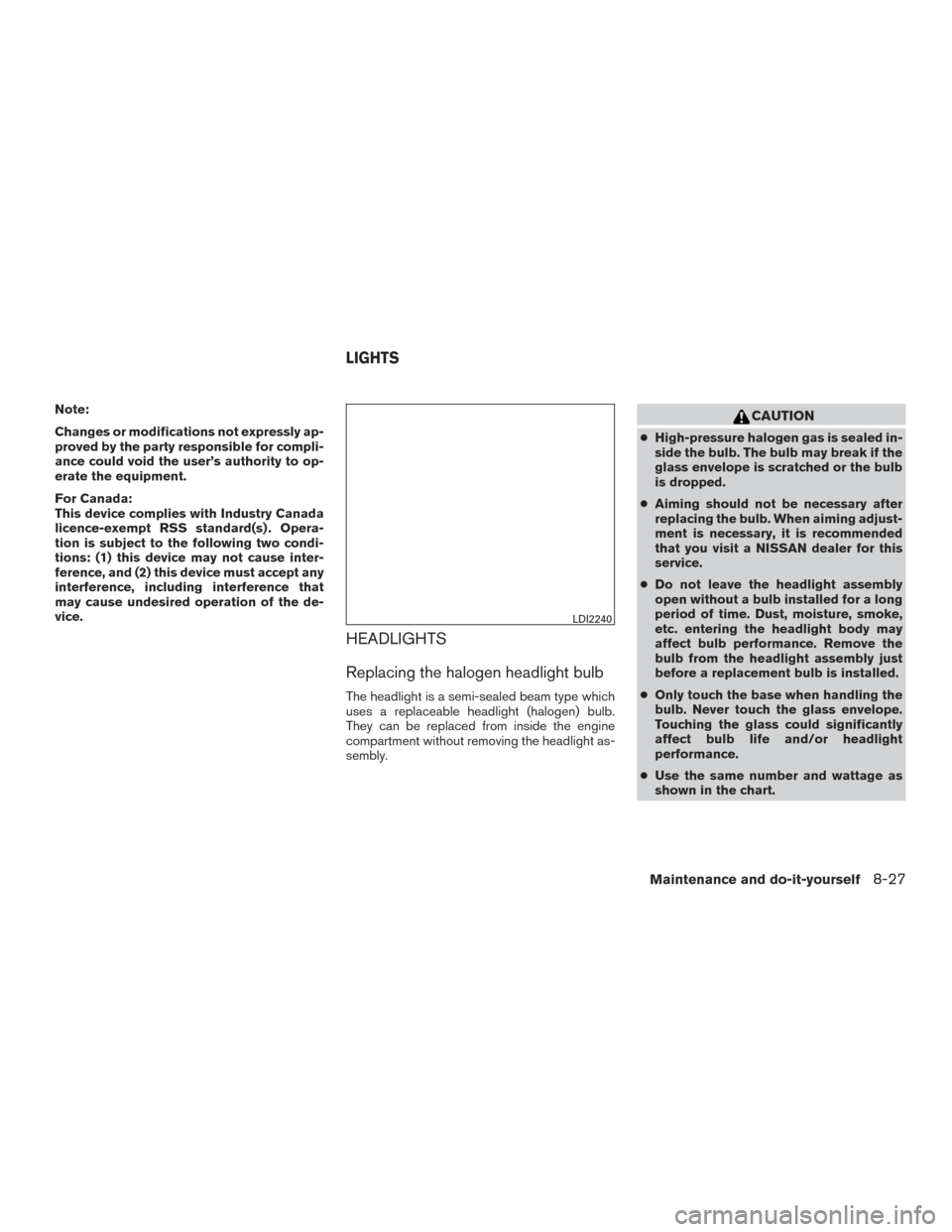
Note:
Changes or modifications not expressly ap-
proved by the party responsible for compli-
ance could void the user’s authority to op-
erate the equipment.
For Canada:
This device complies with Industry Canada
licence-exempt RSS standard(s) . Opera-
tion is subject to the following two condi-
tions: (1) this device may not cause inter-
ference, and (2) this device must accept any
interference, including interference that
may cause undesired operation of the de-
vice.
HEADLIGHTS
Replacing the halogen headlight bulb
The headlight is a semi-sealed beam type which
uses a replaceable headlight (halogen) bulb.
They can be replaced from inside the engine
compartment without removing the headlight as-
sembly.
CAUTION
●High-pressure halogen gas is sealed in-
side the bulb. The bulb may break if the
glass envelope is scratched or the bulb
is dropped.
● Aiming should not be necessary after
replacing the bulb. When aiming adjust-
ment is necessary, it is recommended
that you visit a NISSAN dealer for this
service.
● Do not leave the headlight assembly
open without a bulb installed for a long
period of time. Dust, moisture, smoke,
etc. entering the headlight body may
affect bulb performance. Remove the
bulb from the headlight assembly just
before a replacement bulb is installed.
● Only touch the base when handling the
bulb. Never touch the glass envelope.
Touching the glass could significantly
affect bulb life and/or headlight
performance.
● Use the same number and wattage as
shown in the chart.
LDI2240
LIGHTS
Maintenance and do-it-yourself8-27
Page 355 of 402
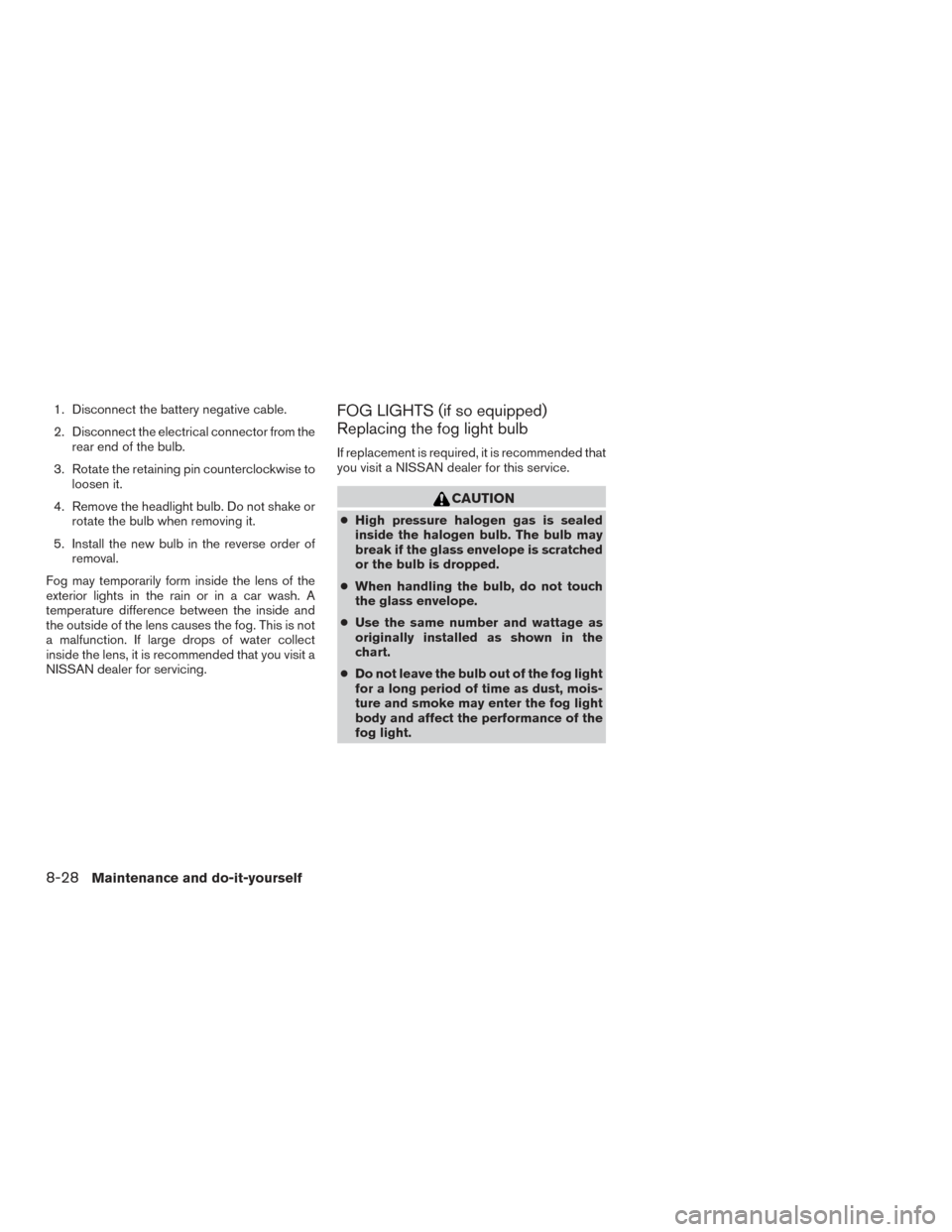
1. Disconnect the battery negative cable.
2. Disconnect the electrical connector from therear end of the bulb.
3. Rotate the retaining pin counterclockwise to loosen it.
4. Remove the headlight bulb. Do not shake or rotate the bulb when removing it.
5. Install the new bulb in the reverse order of removal.
Fog may temporarily form inside the lens of the
exterior lights in the rain or in a car wash. A
temperature difference between the inside and
the outside of the lens causes the fog. This is not
a malfunction. If large drops of water collect
inside the lens, it is recommended that you visit a
NISSAN dealer for servicing.FOG LIGHTS (if so equipped)
Replacing the fog light bulb
If replacement is required, it is recommended that
you visit a NISSAN dealer for this service.
CAUTION
● High pressure halogen gas is sealed
inside the halogen bulb. The bulb may
break if the glass envelope is scratched
or the bulb is dropped.
● When handling the bulb, do not touch
the glass envelope.
● Use the same number and wattage as
originally installed as shown in the
chart.
● Do not leave the bulb out of the fog light
for a long period of time as dust, mois-
ture and smoke may enter the fog light
body and affect the performance of the
fog light.
8-28Maintenance and do-it-yourself
Page 356 of 402
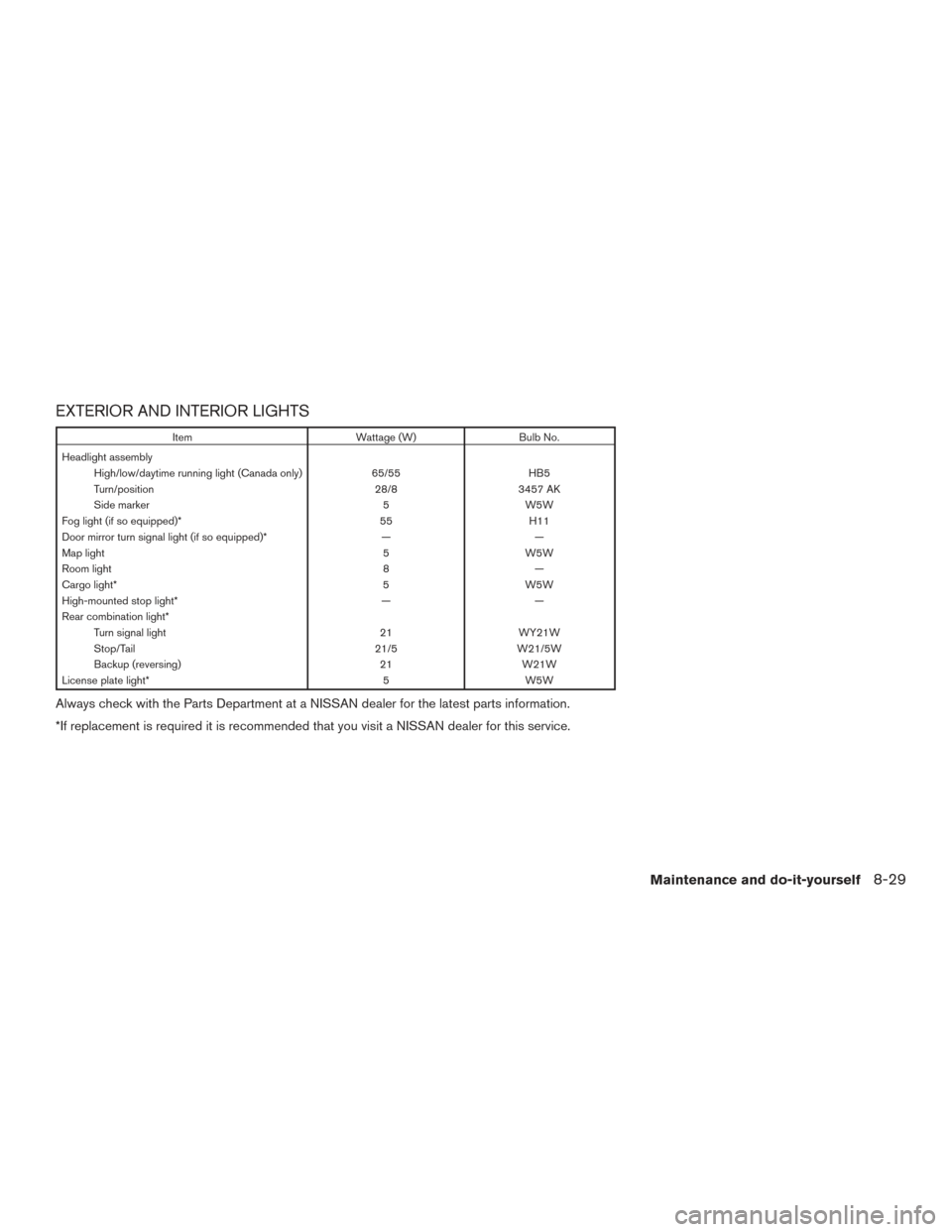
EXTERIOR AND INTERIOR LIGHTS
ItemWattage (W)Bulb No.
Headlight assembly High/low/daytime running light (Canada only) 65/55HB5
Turn/position 28/83457 AK
Side marker 5W5W
Fog light (if so equipped)* 55H11
Door mirror turn signal light (if so equipped)* ——
Map light 5W5W
Room light 8—
Cargo light* 5W5W
High-mounted stop light* ——
Rear combination light* Turn signal light 21WY21W
Stop/Tail 21/5W21/5W
Backup (reversing) 21W21W
License plate light* 5W5W
Always check with the Parts Department at a NISSAN dealer for the latest parts information.
*If replacement is required it is recommended that you visit a NISSAN dealer for this service.
Maintenance and do-it-yourself8-29
Page 358 of 402
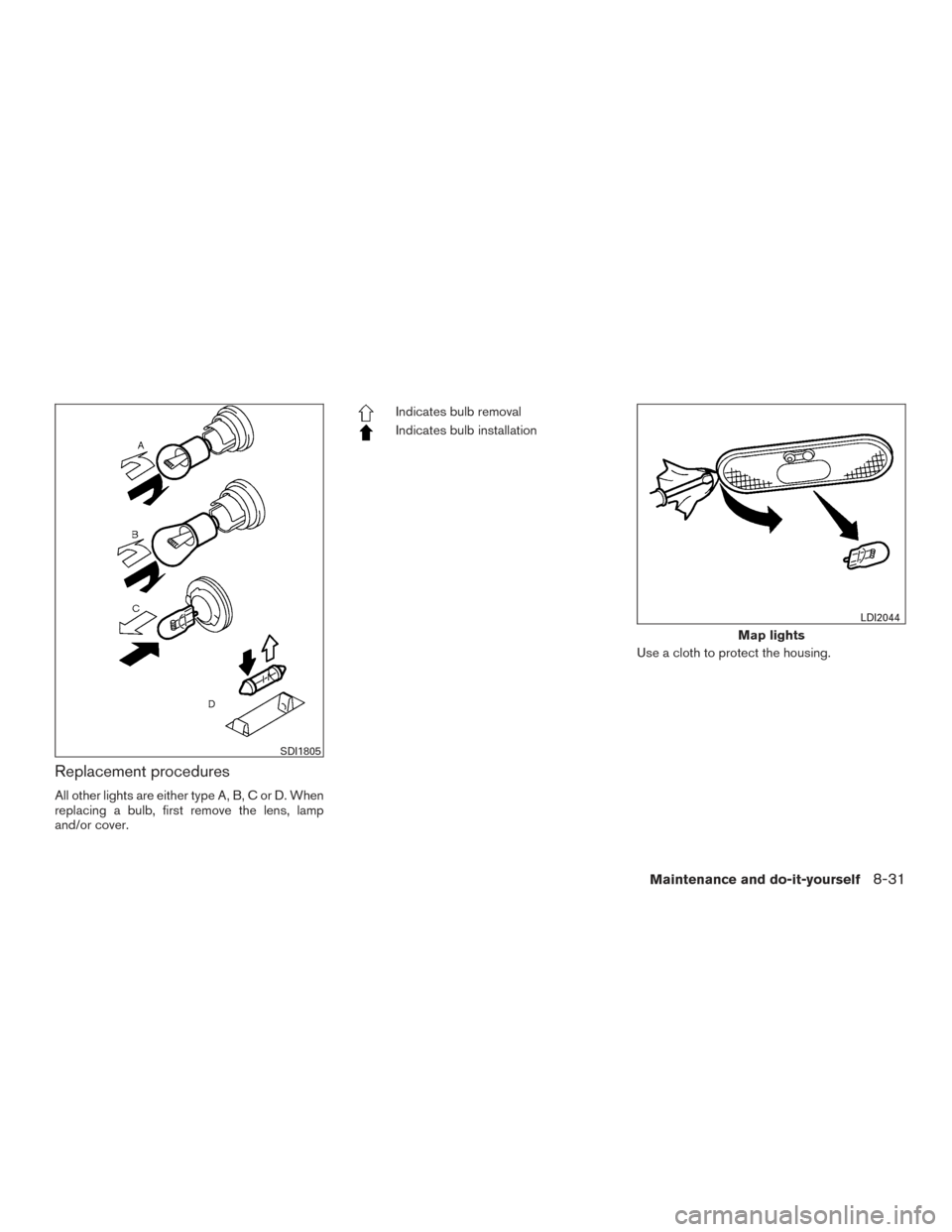
Replacement procedures
All other lights are either type A, B, C or D. When
replacing a bulb, first remove the lens, lamp
and/or cover.
Indicates bulb removal
Indicates bulb installationUse a cloth to protect the housing.
SDI1805
Map lights
LDI2044
Maintenance and do-it-yourself8-31
Page 396 of 402
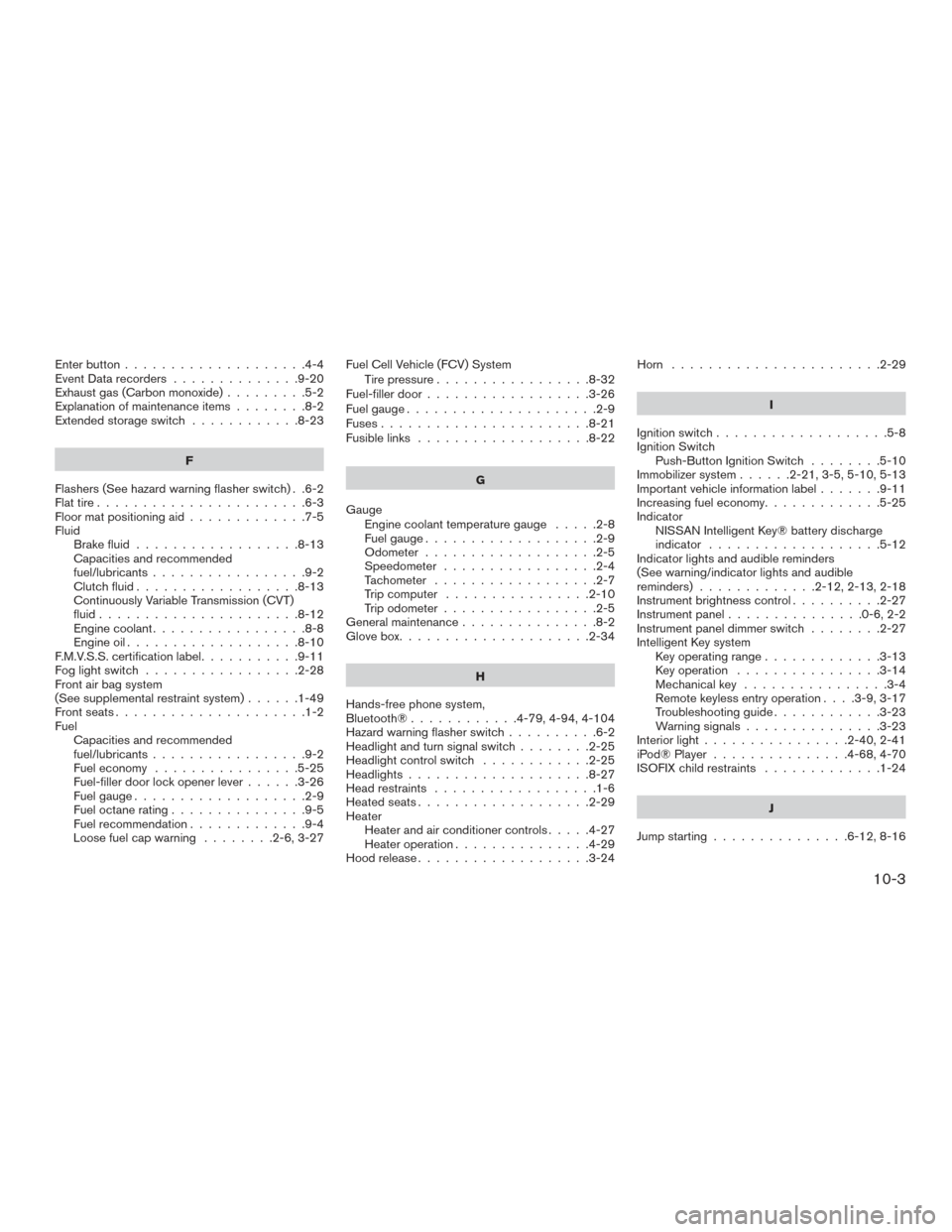
Enterbutton....................4-4
Event Data recorders..............9-20
Exhaust gas (Carbon monoxide) .........5-2
Explanation of maintenance items ........8-2
Extendedstorageswitch ............8-23
F
Flashers (See hazard warning flasher switch) . .6-2
Flat tire .......................6-3
Floor mat positioning aid .............7-5
Fluid Brake fluid ..................8-13
Capacities and recommended
fuel/lubricants .................9-2
Clutchfluid..................8-13
Continuously Variable Transmission (CVT)
fluid......................8-12
Engine coolant .................8-8
Engine oil ...................8-10
F.M.V.S.S. certification label ...........9-11
Foglightswitch .................2-28
Front air bag system
(See supplemental restraint system) ......1-49
Frontseats.....................1-2
Fuel Capacities and recommended
fuel/lubricants .................9-2
Fuel economy ................5-25
Fuel-filler door lock opener lever ......3-26
Fuel gauge ...................2-9
Fuel octane rating ...............9-5
Fuel recommendation .............9-4
Loose fuel cap warning ........2-6,3-27 Fuel Cell Vehicle (FCV) System
Tirepressure.................8-32
Fuel-filler door ..................3-26
Fuelgauge.....................2-9
Fuses.......................8-21
Fusiblelinks ...................8-22
G
Gauge Engine coolant temperature gauge .....2-8
Fuel gauge ...................2-9
Odometer ...................2-5
Speedometer .................2-4
Tachometer ..................2-7
Trip computer ................2-10
Trip odometer .................2-5
General maintenance ...............8-2
Glovebox.....................2-34
H
Hands-free phone system,
Bluetooth®............4-79,4-94,4-104
Hazard warning flasher switch ..........6-2
Headlight and turn signal switch ........2-25
Headlight control switch ............2-25
Headlights ....................8-27
Head restraints ..................1-6
Heated seats ...................2-29
Heater Heater and air conditioner controls .....4-27
Heater operation ...............4-29
Hood release ...................3-24 Horn .......................2-29
I
Ignition switch ...................5-8
Ignition Switch Push-Button Ignition Switch ........5-10
Immobilizer system ......2-21,3-5,5-10,5-13
Important vehicle information label .......9-11
Increasing fuel economy .............5-25
Indicator NISSAN Intelligent Key® battery discharge
i
ndicator ...................5-12
Indicator lights and audible reminders
(See warning/indicator lights and audible
reminders).............2-12,2-13,2-18
Instrument brightness control ..........2-27
Instrumentpanel...............0-6,2-2
Instrument panel dimmer switch ........2-27
Intelligent Key system Key operating range .............3-13
Key operation ................3-14
Mechanical key ................3-4
Remote keyless entry operation ....3-9,3-17
Troubleshooting guide ............3-23
Warning signals ...............3-23
Interior light ................2-40,2-41
iPod®Player ............... 4-68, 4-70
ISOFIX child restraints .............1-24
J
Jump starting ...............6-12,8-16
10-3
Page 397 of 402
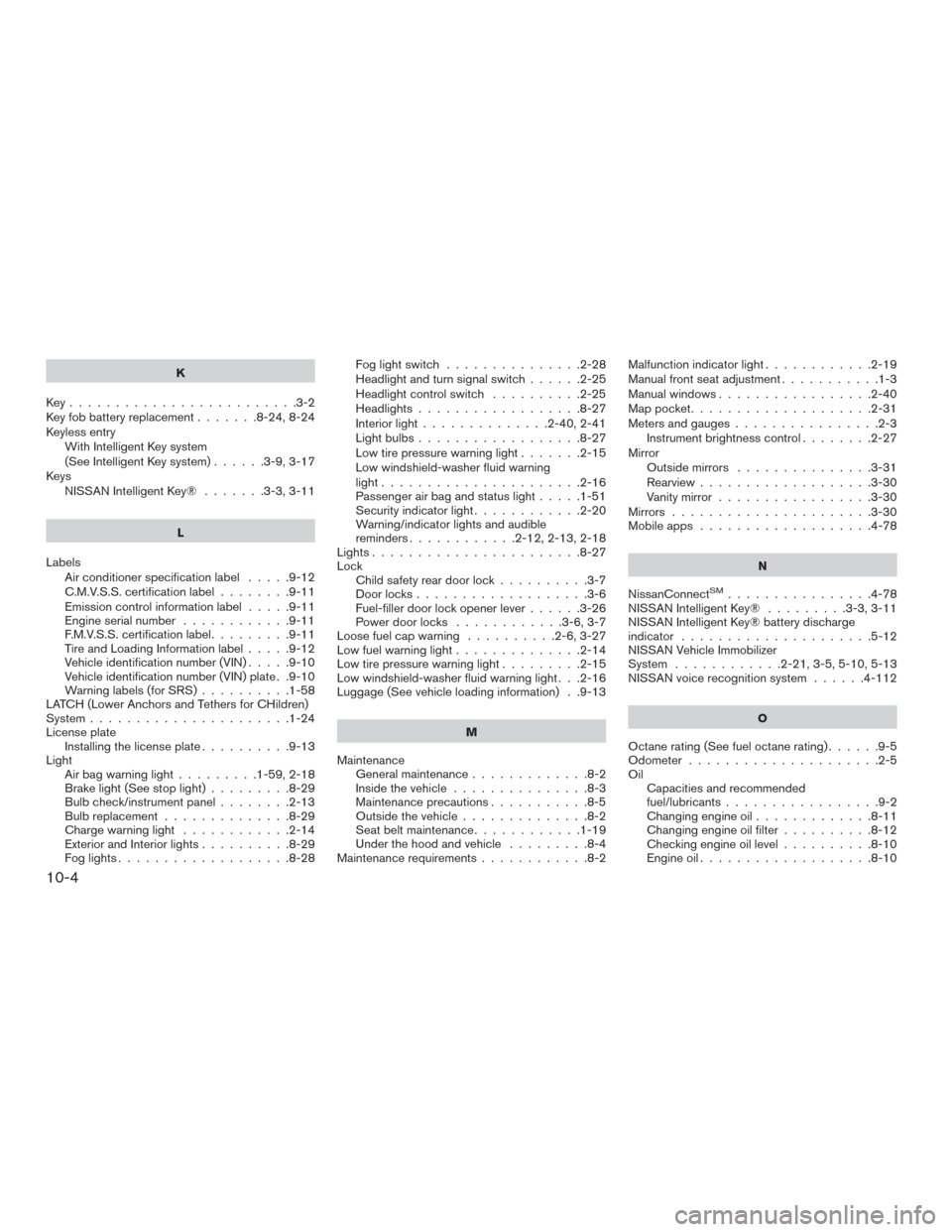
K
Key.........................3-2
Key fob battery replacement .......8-24,8-24
Keyless entry With Intelligent Key system
(See Intelligent Key system) ......3-9,3-17
Keys NISSAN Intelligent Key® .......3-3,3-11
L
Labels Air conditioner specification label .....9-12
C.M.V.S.S. certification label ........9-11
Emissioncontrolinformationlabel.....9-11
Engine serial number ............9-11
F.M.V.S.S. certification label .........9-11
Tire and Loading Information label .....9-12
Vehicle identification number (VIN) .....9-10
Vehicle identification number (VIN) plate . .9-10
Warning labels (for SRS) ..........1-58
LATCH (Lower Anchors and Tethers for CHildren)
System ......................1-24
License plate Installing the license plate ..........9-13
Light Airbagwarninglight.........1-59,2-18
Brake light (See stop light) .........8-29
Bulb check/instrument panel ........2-13
Bulb replacement ..............8-29
Charge warning light ............2-14
ExteriorandInteriorlights..........8-29
Foglights...................8-28 Foglightswitch ...............2-28
Headlight and turn signal switch
......2-25
Headlight control switch ..........2-25
Headlights..................8-27
Interiorlight..............2-40,2-41
Lightbulbs..................8-27
Low tire pressure warning light .......2-15
Low windshield-washer fluid warning
light......................2-16
Passenger air bag and status light .....1-51
Security indicator light ............2-20
Warning/indicator lights and audible
reminders ............2-12,2-13,2-18
Lights.......................8-27
Lock Child safety rear door lock ..........3-7
Door locks ...................3-6
Fuel-filler door lock opener lever ......3-26
Power door locks ............3-6,3-7
Loose fuel cap warning ..........2-6,3-27
Lowfuelwarninglight..............2-14
Low tire pressure warning light .........2-15
Low windshield-washer fluid warning light . . .2-16
Luggage (See vehicle loading information) . .9-13
M
Maintenance Generalmaintenance.............8-2
Insidethevehicle...............8-3
Maintenance precautions ...........8-5
Outside the vehicle ..............8-2
Seatbeltmaintenance............1-19
Underthehoodandvehicle .........8-4
Maintenancerequirements............8-2 Malfunction indicator light
............2-19
Manual front seat adjustment ...........1-3
Manual windows .................2-40
Mappocket....................2-31
Meters and gauges ................2-3
Instrument brightness control ........2-27
Mirror Outside mirrors ...............3-31
Rearview ...................3-30
Vanity mirror .................3-30
Mirrors ......................3-30
Mobileapps ...................4-78
N
NissanConnect
SM................4-78
NISSAN Intelligent Key® .........3-3,3-11
NISSAN Intelligent Key® battery discharge
indicator .....................5-12
NISSAN Vehicle Immobilizer
System ............2-21,3-5,5-10,5-13
NISSAN voice recognition system ......4-112
O
Octane rating (See fuel octane rating) ......9-5
Odometer .....................2-5
Oil Capacities and recommended
fuel/lubricants.................9-2
Changingengineoil.............8-11
Changing engine oil filter ..........8-12
Checking engine oil level ..........8-10
Engineoil...................8-10
10-4